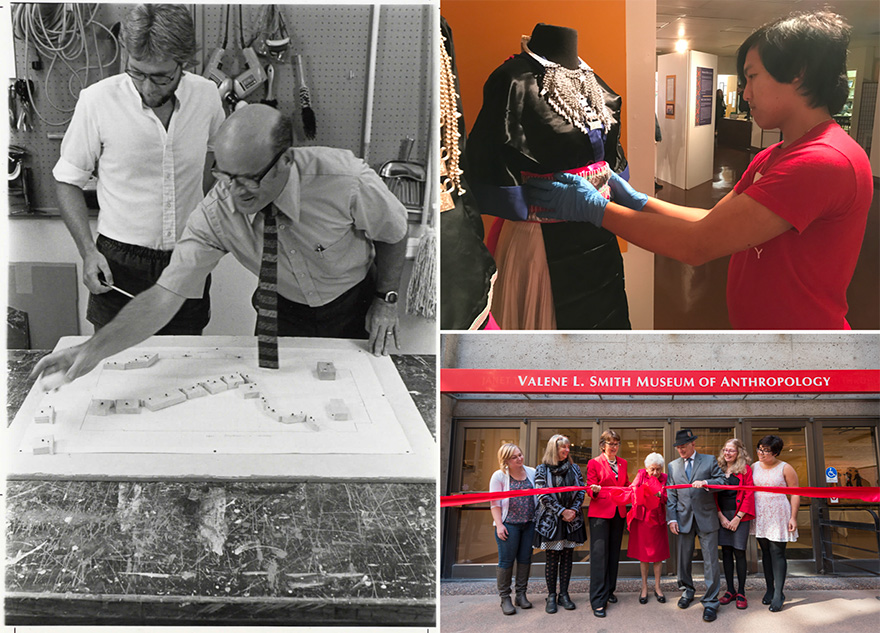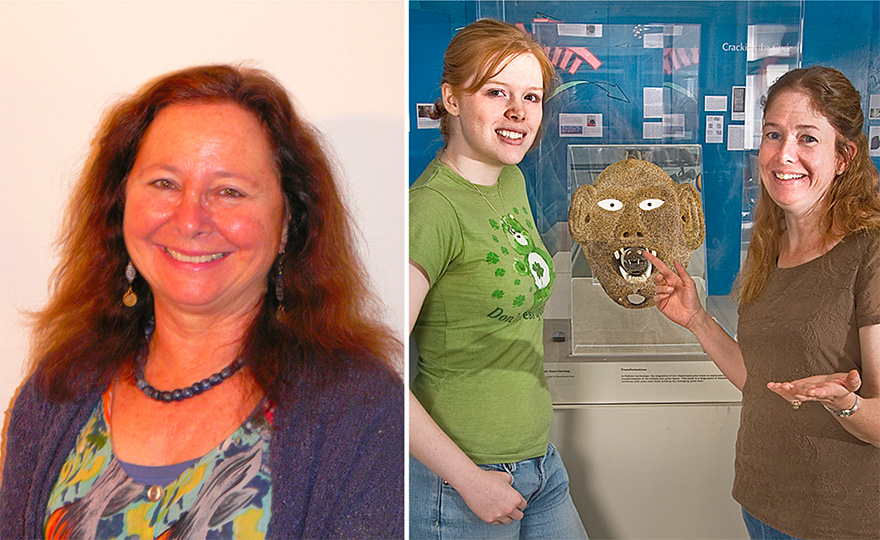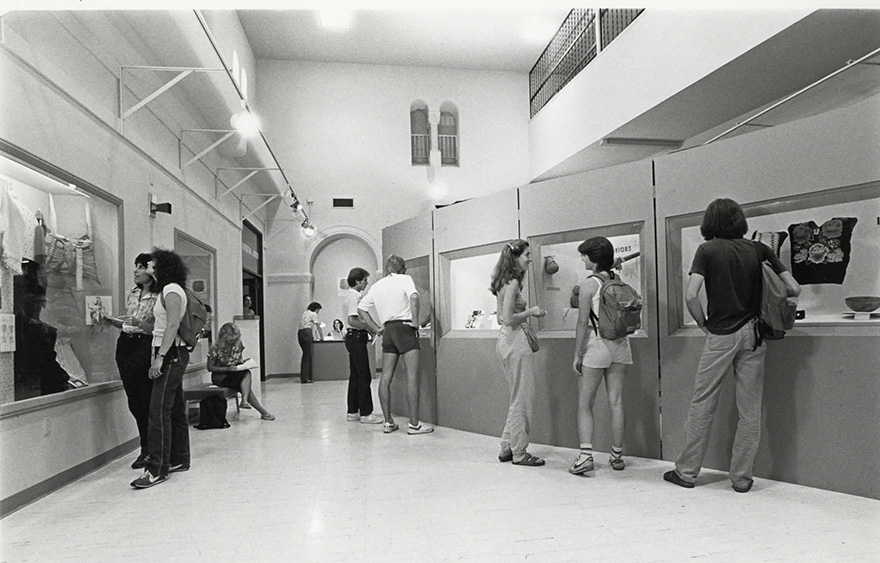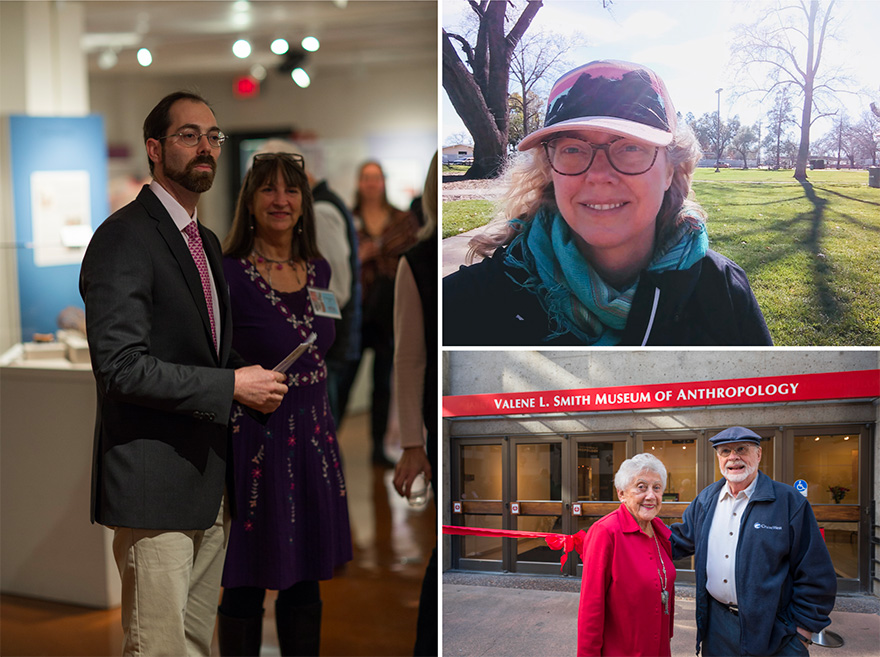Celebrating 50 Years at the Museum
By Heather McCafferty, Assistant Curator
In the fall of 2020, the museum celebrated a half-century of hands-on educational opportunities for students and visitors alike. When the coronavirus pandemic shifted plans for an in-person Gala Celebration, the museum faculty and staff pivoted to a virtual celebration that took place during Alumni Family Weekend. In honor of the anniversary, the museum offered a virtual tour of the museum’s exhibition, Unbroken Traditions: Basketweavers of the Meadows-Baker Families of Northern California. The virtual live tour took place on October 9 and was guided by Meegan Sims and Coral Doyle, two Museum Studies graduate students who curated the gallery exhibit, as well as museum faculty, staff, and Tribal partners. Participants learned about the artistry, generational wisdom, and traditional ecological knowledge that goes into creating Native California baskets.
On October 10, the museum welcomed faculty, staff, board, alumni, members, and friends, and guests to celebrate at the Cheers to 50 Years virtual anniversary gathering. Attendees were invited to dress in their favorite pattern (plaid or polka dots anyone?) and make a batch of sweet and spicy roasted nuts and cider spritzers to toast the occasion using recipes provided in the invitation. At the gathering, guests watched the debut of a video chronicling the museum’s history and were treated to a special guest appearance by the museum’s founder, Keith Johnson. The gathering reflected the close-knit connections and many success stories that the museum and Museum Studies Program cultivates. Attendees enjoyed and shared lively conversations and anecdotes of how the museum has touched their lives.

From left, museum founder, Keith Johnson, works on a floor plan for an exhibition in the 1980s. Upper right, student curator, Jonathan Vang, prepares a mannequin for display. Lower right, Dr. Valene Smith cuts the ribbon for the expansion for the museum in 2017.
The history of the CSU, Chico Museum of Anthropology began in 1970, when Keith Johnson, an archaeologist in the Department of Anthropology, turned an idea of a hands-on museum into reality. The first exhibition at the newly minted Museum of Anthropology, Dimensions in Anthropology, opened to the public on February 27, 1970. As Keith Johnson reminisces:
“After the resounding success of the first museum methods class, I realized the museum emphasis should be changed from the usual object collecting and exhibiting institution to a student teaching and training museum. The Museum of Anthropology was the first such museum in California, indeed, in the USA” - Keith Johnson 2020
Over the next 30 years, Keith oversaw the development of a thriving Museum Studies Program that offered students a hands-on learning laboratory through the Museum of Anthropology. The program expanded to include coursework in collections management, museum administration, museum theory, and exhibition research, design, and installation. By 1979, a Museum Certificate program was formalized, followed by a Master of Arts in Anthropology with an Option in Museum Studies in 1982.
 Anthropology Professor Emeritus and former Museum Co-Director, Dr. Stacy Schaefer (pictured left). Museum studies student (left) and museum Curator, Adrienne Scott (right)
Anthropology Professor Emeritus and former Museum Co-Director, Dr. Stacy Schaefer (pictured left). Museum studies student (left) and museum Curator, Adrienne Scott (right)
The museum was originally housed in the foyer of Trinity Hall. Johnson oversaw students in the creation of exhibits that explored topics ranging from the Egyptian Afterlife to local pre-history and history to American food traditions. Beginning in 1985, the museum added a second annual exhibit to the schedule with a yearly student-curated photography show that became a nationally advertised juried photo contest and exhibition. Each year contest entries were received from across the United States. The museum also offered programming like lectures, films, tours, and special field trips that were supported by donations to the Museum Alliance, the museum’s membership program. In 1995, after 25 years in Trinity Hall, the museum moved to the third floor of Langdon Hall.
Four years later, in 1999, Keith Johnson taught his last museum course and retired from the university in 2002. Johnson has continued to be involved with the local museum community over the years and continues to be a steadfast member and supporter of the museum that he founded. He also established two scholarships: The Edna May Johnson Scholarship, which provides an annual scholarship that is specifically for Department of Anthropology Museum Studies students, and the Keith Johnson Scholarship, an annual scholarship awarded to a deserving Anthropology student.
In 1999, Dr. Stacy Schaefer was hired as a professor of Cultural Anthropology and Director of the Museum Studies Program. Dr. Schaefer had experience working at the DeYoung Museum and was a professor of Anthropology at University of Texas Pan American prior to joining the Department of Anthropology. With her experience in ethnographic field work among the Huichol (Wixárika) Indigenous peoples of the Sierra Madre Occidental range in Mexico, Dr. Schaefer took the museum into a new direction by embracing the participatory museum model in her classes and exhibitions. This model emphasizes working with community consultants to create exhibits that reflect diverse voices and perspectives. As Stacy remembers:
I felt it imperative to bring diversity and multi-cultural awareness to campus and the Museum was an ideal venue to do this.
 Museum visitors explore an exhibition in Trinity Hall, the museum’s former location, in 1982.
Museum visitors explore an exhibition in Trinity Hall, the museum’s former location, in 1982.
In 2001, Dr. Georgia Fox, an archaeologist with a background in artifact conservation came on board. Dr. Fox received her Ph.D. in Anthropology from Texas A & M in 1998 and went on to serve as the Curator of the Santa Barbara Maritime Museum before being hired in the Department of Anthropology at CSU Chico. Her contributions to the museum program included the founding of the Heritage Resources Conservation Laboratory (HRCL) on campus and expanding the collections management and exhibitions courses to expose students to best practices in collections care, utilizing the proper materials, methodologies, and documentation required toward contemporary collections stewardship, including working with Indigenous peoples. Students came away grounded in industry standards and equipped to handle real-world challenges that museum professionals encounter. Georgia notes:
The Museum Studies Program offers the latest knowledge in best practices, industry standards, and approaches with hands-on training backed by sound pedagogy and theoretical underpinnings.
The museum’s first permanent staff position was filled in 2001 by Adrienne Scott. Previously, the museum’s Curator position was staffed on a rolling basis by Museum Studies Program students, who deepened their skills in this position. Adrienne came to the museum with a B.A. in Anthropology from Indiana University, Bloomington, and later earned an MA in Education with an emphasis in Curriculum and Instruction from CSU, Chico. In addition to her supportive role in the creation of the annual spring exhibition, she has created award-winning museum educational programming and expanded the museum’s network and collaborations on campus, in the Chico community, and in the North State. Her relationships with community educators strengthened both the K-12 and college tour programs. The museum now holds annual educational events and programs, including the beloved summer camp, Night at the Museum, Museum Monster Mayhem, and the new regional collaboration with Explore Butte County, Museum Weekend. Adrienne remarks:
Museums are a place to work out meanings. Exhibits add to the stories of the past by highlighting muted voices of history. In this way and with primary documents and artifacts we help show how the past is always in motion.
With this new team in place, the museum embarked on a new era. In 2009, the museum was promised a bequest from Anthropology Department Emeritus Professor Dr. Valene L. Smith. Dr. Smith was a professor in the Anthropology Department from 1967 to 1988 and pioneered the field of Cultural Tourism, which is the study of tourism from an anthropological perspective. Her edited volume, Hosts and Guests (1977) was a seminal work and remains a foundational text in the field of the anthropology of tourism. Among her many awards, recently, in 2018, she was awarded the 14th United Nations World Tourism Organization’s (UNWTO) Ulysses Prize Laureate for Excellence in the Creation and Dissemination of Knowledge in Tourism at the International Tourism Trade Fair in Madrid, Spain. Dr. Smith's energy and optimism made her a favorite professor who was nominated as Outstanding Professor in 1981–82. It was her promised gift that allowed the museum to move to a new, more prominent, location on campus on the bottom floor of the Meriam Library. The gift was celebrated with a grand opening reception for a new exhibition, Living on Top of the World, that featured parts of Valene’s collection acquired during years of fieldwork in the Arctic. The museum also unveiled a new sign bearing a new name in honor of Valene’s generosity, The Valene L. Smith Museum of Anthropology.
In 2010, the museum created a new position that was filled by Heather McCafferty, the current museum Assistant Curator. Heather earned a Masters in Anthropology with an Emphasis in Museum Studies, from CSU, Chico in 2008. She brought an interest in exhibition curation, which she honed during her work as the Curator at the Chico Museum. She works closely with museum faculty and staff supporting and mentoring students in the Museum Studies Program and has helped to expand the museum’s exhibition offerings, with the addition of a graduate student-curated exhibition that she oversees. The museum’s community partnerships and collaborations and have grown under Heather’s leadership, as she has established programs, lectures, and fundraiser events that are held at off-campus venues. Her research focus on sustainability has deepened the museum’s commitment to integrating sustainability into programs and practices.
Heather states that:
"Museum Studies students participate in the museum’s annual schedule of programs including exhibitions, school tours, family days, lectures, events, and fundraisers. These real-world experiences enhance their training and prepare them for professional museum careers."
 From left, Museum Director, Dr. William Nitzky, pictured with Museum Anthropology Professor Emeritus and former Museum Co-Director, Dr. Georgia Fox. Upper right, museum Assistant Curator, Heather McCafferty. Lower right, Dr. Valene Smith with Keith Johnson enjoy the moment together at the museum expansion in 2017.
From left, Museum Director, Dr. William Nitzky, pictured with Museum Anthropology Professor Emeritus and former Museum Co-Director, Dr. Georgia Fox. Upper right, museum Assistant Curator, Heather McCafferty. Lower right, Dr. Valene Smith with Keith Johnson enjoy the moment together at the museum expansion in 2017.
With a robust Museum Studies Program and a new space, the museum’s trajectory shifted again when Dr. Schaefer retired in 2014 and Dr. William (Will) Nitzky joined the Anthropology Department in 2015. Dr. Nitzky is a cultural anthropologist who received a Ph.D. in Sociocultural Anthropology from Arizona State University in 2014. He has contributed a renewed focus on more participatory, inclusive, accessible, and collaborative strategies at the museum along with the integration of new technologies. He has incorporated ethnographic filmmaking into exhibit curation and directed students in ANTH 467 Exhibit Research, Design, and Installation class in creating the first large-scale virtual exhibition. Since arriving, Dr. Nitzky has helped to create two new courses: Current Topics in Museum Studies and Museum Education. As Will observes:
Museums have an important role in society to stay relevant and serve their publics. Today, I believe this means contributing to social change and respectfully and sincerely working to contribute to a more just and equitable future.
In 2017 the museum expanded, thanks to an additional gift from Dr. Smith when the Janet Turner Print Museum vacated and moved to the new Humanities and Fine Arts Building. With a second gallery space, the museum has been able to add more exhibitions to their annual schedule that are curated by graduate students in the Museum Studies Program.
Today, providing students with an enriching hands-on education remains at the heart of the work that the museum undertakes. The Museum Studies Program continues to be grounded in teaching current museum best practices to students within a firm theoretical framework. As a campus-based learning laboratory, students cultivate their skills in exhibition curation, collection management, educational programming, fundraising and public events, and administration. Graduates from the Museum Studies Program have gone on to enjoy successful professional careers at museums and other institutions nationwide. Recent graduates have found work at the Turtle Bay Museum, Oakland Museum, Chico Children’s Museum, the California Department of Parks and Recreation Museum Collections Center in Sacramento, the Railroad Museum, LA County Museum of Art, Missouri State Parks, and the Museum of Anthropology, the University of Oregon, and the State of Texas, just to name a few.
The pandemic presented a new challenge and a new chapter in the museum’s 50-year history. Museum faculty and staff have stepped up to embrace the new virtual world, training students along the way as they acquire new skill sets with virtual exhibitions, tours, and programs. Fulfilling the museum’s mission to promote respect and appreciation for human cultural diversity has never been more important. We reflect on five decades of successful graduates doing the important work of preserving and interpreting cultural heritage, forging ahead toward an unknown future. The collective stories we tell help us make sense of our changing world. Then as of now, the program is strengthened by the sum of its graduates and their good work for their respective communities. The faculty, staff, and students of the Anthropology Department’s Museum Studies Program continue to strive for excellence and accessibility, giving us all a renewed purpose as we enter a new chapter.

